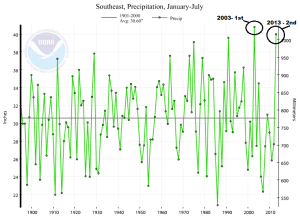Did we have too much rain this summer? How will it affect our winter-feeding strategy?
For most of us, this summer was a complete 180 from previous years. The rainfall total for January to July for the SE United States was the second wettest on record. That is great if you are trying to grow forage, but its bad if you are trying to cut, rake, and bale hay. For many, this has resulted in: 1. grass harvested at much higher maturity than anticipated and/or 2. hay that was cut, but rained on before it could be raked and baled. This can have major implications on utilizing the hay for winter-feeding programs. Given the dilemma, here are a few strategies to consider:
- FORAGE TESTING. Hands down, this the first and foremost step. The cost of the test will pale in comparison to the money saved either in feed cost if the forage is better than expected, or the cost of lower conception rates if the forage is not as good as expected.
- Liquid or Dry Protein Supplements. There are three major advantages to liquid, block, or tub-based protein supplements; those are convenience, reduced labor, and increased forage intake. These can be an excellent source of protein when a small amount is needed to bridge the gap with marginal hays, especially with dry cows. However, like with any other feed, they need to be analyzed to ensure they are meeting the nutritional needs of the animals in a cost effective manner. Another positive for many of these is the addition of essential vitamins and macro- and trace-minerals.
- Byproduct Feeding. Many producers do not have the facilities or machinery to handle large amounts of commodity or byproduct feeds. However, with a little ingenuity, such as ton-tote bags, 50-gallon drums, etc., there can be a real opportunity to utilize these. The strategy then becomes pricing and getting these early enough to insure an economical price. Often times, something as simple as a 50:50 mix of corn gluten feed and soybean hulls or straight whole cottonseed can be a versatile ration that can be fed at variable rates to match the hay and cattle stage of production.
These are a few strategies to help deal with low quality hay this winter. No matter the size of your operation, always start by understanding your available nutrients in you forages, and then develop your supplementation strategy around maintaining production in an economically feasible manner. For more information on winter-feeding strategies, contact your local Cooperative Extension Office.

Precipitation in the Southeast from January 2013 through July 2013. 2013 is the second wettest year so far for this region. Image Credit: NCDC
